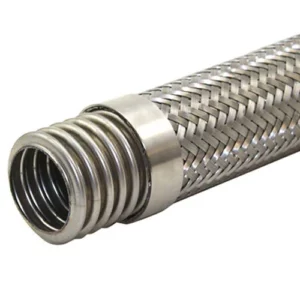A Comparison of Different Types of Stainless Steel Hydraulic Hose
Types of Stainless Steel Hydraulic Hose-Hydraulic hoses are an integral component of hydraulic systems used in various industries, including aerospace, construction, agriculture, and mining. They transfer hydraulic fluid from one component to another, providing the necessary power for the system to function. Stainless steel hydraulic hoses are widely used because of their excellent corrosion resistance, durability, and high tensile strength. In this article, we will compare different types of stainless steel hydraulic hoses, their properties, and their applications.
Introduction
Hydraulic hoses are an essential part of hydraulic systems, as they transfer hydraulic fluid from one component to another. Stainless steel hydraulic hoses are highly resistant to corrosion and offer excellent durability, making them ideal for use in harsh environments. In this article, we will compare different types of stainless steel hydraulic hoses and their applications.
Types of Stainless Steel Hydraulic Hoses
There are several types of stainless steel hydraulic hoses, including:
- Type 304 Stainless Steel Hydraulic Hose
- Type 316 Stainless Steel Hydraulic Hose
- Type 321 Stainless Steel Hydraulic Hose
- Type 410 Stainless Steel Hydraulic Hose
Properties of Stainless Steel Hydraulic Hoses
Stainless steel hydraulic hoses offer several advantages over other materials. They are highly resistant to corrosion, making them ideal for use in harsh environments. They also have excellent durability and high tensile strength, which makes them ideal for use in high-pressure applications.
Applications of Stainless Steel Hydraulic Hoses
Stainless steel hydraulic hoses are widely used in various industries, including aerospace, construction, agriculture, and mining. They are ideal for applications where high-pressure hydraulic fluid transfer is required, such as hydraulic lifts, cranes, and mining equipment.
Comparison of Different Types of Stainless Steel Hydraulic Hoses
- Type 304 Stainless Steel Hydraulic Hose: This type of hose is the most commonly used stainless steel hydraulic hose. It is suitable for low-pressure applications and has excellent corrosion resistance.
- Type 316 Stainless Steel Hydraulic Hose: This type of hose is more corrosion-resistant than type 304 and is suitable for high-pressure applications.
- Type 321 Stainless Steel Hydraulic Hose: This type of hose is suitable for high-temperature applications and has excellent corrosion resistance.
- Type 410 Stainless Steel Hydraulic Hose: This type of hose is suitable for applications that require high tensile strength.
Conclusion
Stainless steel hydraulic hoses offer excellent corrosion resistance, durability, and high tensile strength, making them ideal for use in various industries. Type 304, Type 316, Type 321, and Type 410 are different types of stainless steel hydraulic hoses, each with its own unique properties and applications. By understanding the differences between these types of hoses, you can choose the one that is most suitable for your specific needs.
What are the advantages of using stainless steel hydraulic hoses?
Stainless steel hydraulic hoses offer excellent corrosion resistance, durability, and high tensile strength.
What are the applications of stainless steel hydraulic hoses?
Stainless steel hydraulic hoses are widely used in various industries, including aerospace, construction, agriculture, and mining.
Which type of stainless steel hydraulic hose is suitable for high-pressure applications?
Type 316 stainless steel hydraulic hose is suitable for high-pressure applications.
Which type of stainless steel hydraulic hose is suitable for high-temperature applications?
Type 321 stainless steel hydraulic hose is suitable for high-temperature applications.
Can stainless steel hydraulic hoses be used in harsh environments?
Yes, stainless steel hydraulic hoses are highly resistant to corrosion, making them ideal for use in harsh environments.

